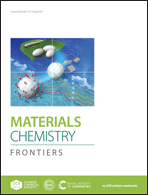Boosting the photoelectric conversion efficiency of DSSCs through graphene quantum dots: insights from theoretical study†
Abstract
The introduction of graphene quantum dots (GQDs) into the photoactive layer of dye-sensitized solar cells (DSSCs) has achieved encouraging experimental results. However, the best linkage configuration between the sensitizer and graphene quantum dots to enhance the photoelectric conversion efficiency of DSSCs is still unclear. Hence, three different covalent bindings (amidation reaction, cycloaddition reaction and free radical addition) were comprehensively investigated from a theoretical perspective. The theoretical investigation indicated that covalent bonding of GQD is beneficial to the optical and electrical properties, especially via the amidation reaction, greatly enhancing the absorption intensity, which further improves the utilization of light and leads to a better photocurrent response. Covalent bonding of GQD via the amidation reaction can improve the maximum photon generated current compared to other covalent behaviors, exhibiting better intermolecular charge transfer character. Based on the analysis of the intermolecular interaction between the dye and I2, covalent bonding of GQD via the amidation reaction can decrease the electron recombination rate. Therefore, covalent bonding of GQD via the amidation reaction is regarded as the most promising approach to enhance the photoelectric conversion efficiency of DSSCs. In addition, various graphene oxide and doped graphene QDs were also studied to provide possibilities for improving the efficiency of DSSCs.



 Please wait while we load your content...
Please wait while we load your content...